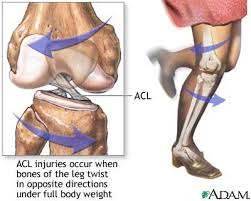Anterior Cruciate Ligament Injury
This injury usually occurs when the knee is forcefully twisted or hyper-extended. Usually the tearing of the ligament occurs with a sudden directional change with the foot fixed on the ground or when a deceleration force crosses the knee. This type of injury is common in soccer, skiing, football, and other sports with lots of stop-and-go movements, jumping, or weaving. Like any other body part, the ACL becomes weaker with age.
Mechanism of Injury
This injury usually occurs when the knee is forcefully twisted or hyper-extended. Usually the tearing of the ligament occurs with a sudden directional change with the foot fixed on the ground or when a deceleration force crosses the knee. This type of injury is common in soccer, skiing, football, and other sports with lots of stop-and-go movements, jumping, or weaving. Like any other body part, the ACL becomes weaker with age.
Pain and Symptoms
- Associated with the injury the person will often hear a ‘pop’, ‘crack’ or feel a ‘snap’ within the knee.
- The knee often swells within the first few hours of the injury. This may be a sign of bleeding inside the knee joint. Swelling that occurs rapidly is usually a sign of a serious knee injury.
- Giving way or instability of the knee particularly with twisting
- Restricted movement and pain, particularly in the first few weeks following the injury
Diagnosis
If an injury to the anterior cruciate ligament is suspected further imaging will be required with the aid of an MRI and a specialist orthopaedic surgeon’s opinion required.
Acute Management
Initial management will focus on decreasing swelling, increasing range of motion and strengthening the leg and hip muscles. Even in situations where surgery is required this is important.
Surgical intervention
The role of surgery is to restore the mechanical stability to the knee. The graft takes around 6 months to fully strengthen. A disrupted cruciate ligament increases the risk of re-injury to the knee due to the instability. It also increases your risk of developing early onset osteoarthritis once again because of the lack of stability in the knee. Surgery involves replacing the torn cruciate ligament with a graft that reproduces the normal stabilising role of the ligament. There are several procedures available and your surgeon can guide you with this. Surgery is usually performed via an arthroscope using the hamstring tendons as a graft.
Post-Operative Treatment
Time: 8-12 months Initial management will focus on increasing range of motion in the knee, improving quadriceps recruitment and managing pain levels. Depending on the surgery bracing will be used initially until a straight leg raise can be performed and crutches will be used for the first 4-6 weeks. Further management will focus on restoring strength, fitness and balance/proprioception. Crucial to the rehabilitation is an ACL injury prevention program.

